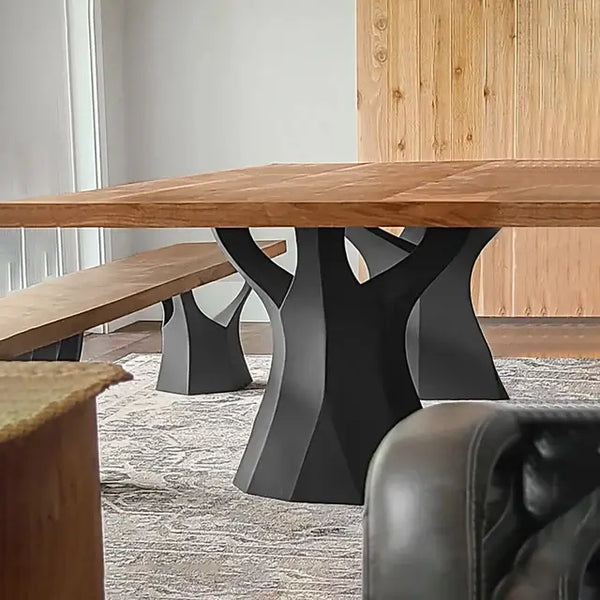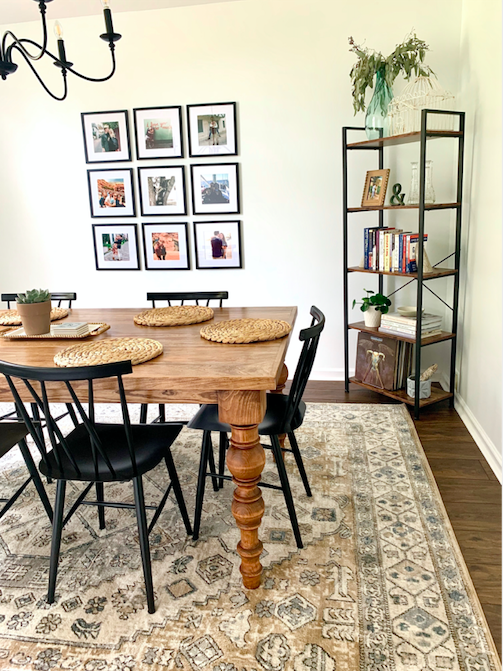Transform Your Dining Space with Stylish Dining Room Table Legs
Wiki Article
From Conventional to Modern: Locate the Perfect Dining Area Table Legs for Your Style
The choice of dining-room table legs plays a critical duty in specifying the total personality of your room, connecting the void in between typical craftsmanship and contemporary appearances. While timeless styles such as cabriole and transformed legs stimulate a feeling of timeless refinement, contemporary designs like hairpin and geometric alternatives provide a chance for striking aesthetic interest. Evaluating the best equilibrium between these styles calls for a nuanced understanding of your existing design and personal preference. As you consider these elements, the concern stays: exactly how can you perfectly integrate these diverse leg styles to produce an unified eating experience?Recognizing Table Leg Styles
The selection of dining-room table leg designs can dramatically affect both the aesthetics and functionality of the room. Each leg design contributes unique visual components and practical features, catering to varied layout choices and usage requirements. Understanding these designs is crucial for selecting the appropriate table that lines up with your overall interior style vision.As an example, conical legs provide a tidy, timeless appearance that can enhance an area's style, while pedestal bases give security and make the most of legroom, making them optimal for smaller sized rooms. Barrette legs, a characteristic of mid-century modern-day layout, present an industrial panache, enabling an airy, open feel. Similarly, trestle legs stimulate rustic appeal, supplying robust assistance and a sense of eternity.
Wooden legs can bring warmth and structure, whereas metal options often share a sleek, modern vibe. Inevitably, comprehending table leg styles is essential for producing a cohesive eating area that reflects individual design while making sure functionality and convenience.
Traditional Table Leg Options
When picking eating area table legs, traditional options usually symbolize ageless style and workmanship. These layouts show a rich heritage and a dedication to high quality, making them ideal for those who value timeless appearances.One of one of the most renowned standard leg styles is the cabriole leg, characterized by its stylish bent form. This design usually features attractive makings and is most frequently discovered in Queen Anne and Chippendale furniture. Another popular option is the transformed leg, which flaunts a series of smooth, rounded shapes that offer a traditional look while maintaining security.
Furthermore, the straight leg, while easy, supplies a basic and strong structure that can blend flawlessly with a variety of tabletop styles. For those attracted to ornate outlining, claw-and-ball feet legs stimulate a sense of magnificence and can function as a spectacular prime focus in any eating area.
Lastly, stand bases, although not strictly legs, supply an alternative conventional option that enables enough legroom and can be beautifully sculpted. Each of these typical leg styles contributes to the total atmosphere of an eating area, marrying feature with aesthetic allure.

Modern Table Leg Layouts
Modern table leg layouts provide a diverse series of styles that emphasize tidy lines and innovative products. These layouts usually focus on functionality while working as striking focal points within an eating space. Minimal aesthetic appeals are common, with legs crafted from materials such as steel, glass, and engineered timber, which add to a modern and airy feel.One preferred design is the barrette leg, characterized by its slim, conical structure that offers stability without overwhelming the table top (dining room table legs). This style is frequently found in mid-century modern-day furnishings and can her response effortlessly match various eating table shapes. An additional fad is using geometric forms, where legs might take on unbalanced or angular forms, adding aesthetic rate of interest and a touch of creativity

Blending Designs for One-of-a-kind Areas
Commonly, house owners look for to create one-of-a-kind dining spaces that reflect their individual design by mixing different layout components. This approach permits the incorporation of diverse looks, causing an unified yet unique atmosphere. As an example, combining a rustic wooden table with streamlined, contemporary metal legs can create a captivating contrast that raises the room's total charm.In addition, incorporating vintage table legs with contemporary table tops can stimulate a feeling of history while keeping a modern-day sensibility. Such mixes not just showcase individual taste yet also encourage creative thinking, enabling homeowners to curate a space that feels both personal and inviting.
Color plays a critical function in this blending procedure; choosing table legs that enhance or comparison with the existing shade scheme can boost visual interest. For instance, whitewashed legs can soften the daring of a dark table surface area, producing a balanced visual.
Tips for Selecting the Right Legs
Selecting the right table legs is necessary for accomplishing both performance and visual allure in your eating area. Begin by thinking about the general design of your area. Traditional settings take advantage of legs that include detailed carvings or turned layouts, while modern spaces might call for smooth, minimal styles.Following, evaluate the elevation and stability of the legs. dining room table legs. Common table range between 28 to 30 inches in elevation, so make certain the legs complement this dimension for convenience. Additionally, robust products, such as browse this site wood or steel, can enhance stability and long life
Examine the leg shape as well-- options include straight, tapered, or stand designs. Straight legs provide a classic appearance, while tapered legs can include a touch of beauty. Pedestal bases provide enough legroom and are perfect for smaller sized areas.
Conclusion
In recap, choosing the ideal dining-room table legs calls for mindful factor to consider of both modern-day and traditional styles. Conventional options such as cabriole and transformed legs use classic elegance, while contemporary styles like barrette and geometric forms offer a contemporary touch. By harmonizing leg style, height, and material with the general decoration, a natural and inviting environment can be attained. Eventually, the chosen table legs need recommended you read to mirror the preferred aesthetic, enhancing the dining experience within the area.The range of eating area table leg designs can substantially influence both the looks and performance of the room. Inevitably, understanding table leg styles is essential for developing a natural dining location that shows personal style while guaranteeing functionality and convenience.One of the most renowned conventional leg designs is the cabriole leg, characterized by its stylish bent shape. Straight legs use a classic appearance, while tapered legs can add a touch of sophistication.In recap, choosing the ideal eating area table legs requires cautious consideration of both modern-day and conventional styles.
Report this wiki page